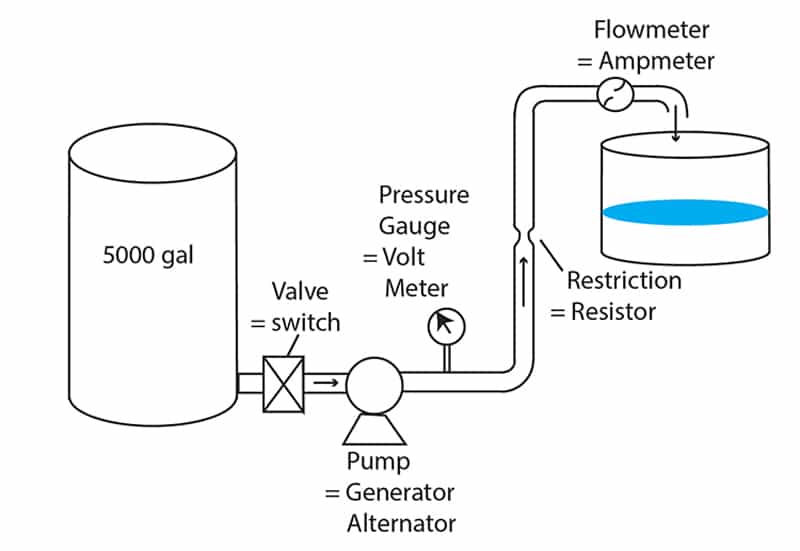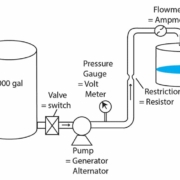Electrical Measurements
To be prepared and understand electrical power usage on a modern vessel, it is important to learn a few basic terms and concepts. These are all applicable to a modern vessel’s electrical energy usage, as well as our daily use on land. Since we cannot directly see electricity, we will use an analogy with water to help illustrate.

Water Analogy
Charge
Consider a tank of water just sitting there. It is ready to flow, but for now, since the valve is closed, it just sits there. This is akin to the electric charge in the plates of a battery; electrons are all gathered around just sitting there waiting to flow.
Voltage
The strength of both AC and DC is measured in units called volts, named after the Italian physicist Alessandro Volta, who also invented the battery – thanks, Alessandro!
As electrical voltage increases, so does the propensity for the electric charge to flow. Voltage may be likened to water pressure in a tank: the higher the pressure in the tank, the more water flows out when you open the valve.
Every sailor who uses electricity for any purpose is well advised to know the voltage level and whether it is AC or DC. Volts can burn, maim, or even kill if improperly handled.
If your sailing takes you to other countries, you will want to be aware of these differences as they will influence your electrical devices, plug converters, and shore power hookup.
The voltage in most automobiles and boats globally is 12 volts DC although larger boats can be 24 volts. There is a new movement to go to 48-volt DC. In the coming years, you will see this.
Ampere
The ampere, better known as the amp, is named after the French mathematician and physicist André-Marie Ampère. An amp is the measure of current. It is the flow rate of electric charge.
Amps may be thought of as water flowing through a pipe. The faster the flow, the more cups per second of water drain out of the tank. Similarly, the higher the number of amps (the current), the more charge drains from your battery.
Starting an engine requires a lot of current—upward of 100 amps. In contrast, operating a simple GPS unit takes very little current—less than 1 amp.
Ohm
An ohm is a measure of how much resistance there is to the flow of charge. The ohm is named after the German physicist Georg Ohm who realized there was a direct linear relationship between the amount of voltage applied and the amount of current that flows for a given resistance.
Going back to the water analogy, resistance is akin to a restriction in the water pipe. When you kink your garden hose, the kink adds resistance and the water flow rate slows. Likewise, adding resistance to an electrical circuit reduces the current flow.
Ohm discovered that, like water, when you double the pressure with a constant resistance, you double the flow. Or if you double the resistance with constant pressure, you halve the flow.
Ohm’s law states: Current (in amps) = Volts / Resistance (in ohms)
This relationship is particularly important when it comes to safety. Our human body has a certain resistance to the flow of charge being passed through it. As the voltage increases, more charge per second (current) will pass through. As we get up to the 110-volt to 220-volt range, the current becomes lethal. But even 12 volts can give you a nasty burn across a wet finger.
Watts and Joules
The watt, named after Scottish engineer James Watt, is the electrical unit used to measure the consumption rate of electrical energy. Energy is expressed in units of joules, named after the English physicist James Prescott Joule. When energy is being consumed at the flow rate of 1 joule per second, then the consumption rate is 1 watt.
A battery holds energy in the form of electrically charged plates. When you drain much of the energy from the battery, the battery is deemed flat. The flow rate at which you drain the energy out is expressed in terms of watts. The bigger the flow rate of the drain (wattage), the quicker the energy stored in the battery is drained.
Energy and the flow rate of energy are cool stuff. Follow it from the source to its use in the following example. In a hydroelectric dam, the water held in the lake is called potential energy. As the water begins to race down the surge pipes to the turbines, it converts its own potential energy to kinetic energy. The faster the water travels in the pipes, the more kinetic energy each liter of water holds. The water then imparts its kinetic energy into the turbine, causing it to spin. The spin energy, as in the alternator discussion above, then converts into AC electrical energy expressed in wattage and delivers it to the electric grid. Power stations are thus rated in megawatts. This is a measure of how many million joules per second the power station delivers to the electric grid.
The energy travels along the electric grid to your house where light bulbs are rated in watts. A 60-watt bulb consumes 60 joules of energy per second.
Relate this to water in the hydroelectric dam: 1 liter of water in a hydropower station falling at 120 mph through the turbine has 1460 joules of kinetic energy. If you use 60 joules per second in your light bulb, the 1460 joules will be consumed in 24 seconds.
Think about this: in your house, if you accidentally leave a 60-watt bulb glowing in your closet for the day while you are at work, you will waste about 200 liters or about 50 gallons of water out of a hydro-dam lake (not accounting for inefficiencies in the generation and transmission systems). As sailors, we are naturally conservationists so this calculation above will surely remind you to turn off lights and other energy-using devices.
More importantly, however, it is a reminder to conserve your battery energy on a boat because of the limited charging ability or the need to start your noisy polluting diesel engine just to charge the batteries.
Batteries in North America are rated in amp-hours. This relates to the amount of energy it holds before the voltage drops below 10.5 volts (10.5 volts is considered flat). The Amp-hour rating, by convention, means the ability to deliver a certain amount of current over 20 hours. A typical marine battery holds 100 amp-hours. This means it could ideally deliver 5 amps of current for 20 hours before it is flat. Or it could power a 60-watt 12-volt bulb for only 20 hours. It is not really very much. In the hydropower station model, that amount of energy is about equivalent to 3000 liters of water imparting its energy to the turbine. Take note and conserve.
kiloWatt.hours (kW.hrs)
Energy is really measured in Joules but a kilowatt Hour is another way of expressing an amount of energy. This is merely because the human baud rate is low – we like to think in hours. Seconds get us a bit flustered. And besides, the number of joules gets quite big because there are 3600 seconds in 1 hour. So kiloWatt.hrs allow us to express energy in more manageable numbers.
A 100-watt (0.1 kiloWatt) light bulb consumes 100 joules of energy every 1 second. If you leave the light bulb on for 1 hour, you will have consumed a certain amount of energy in that hour. How many joules would it have consumed?
This is 100 j/sec x 3600 sec = 360,000 joules.
If this is expressed in watt.hrs it is 100 watts x 1 hr = 100 watt.hrs or 0.1 kiloWatt.hrs.
In much of the world, batteries are rated in the amount of real energy units they hold expressed in kiloWatt.hrs. To convert from amp.hours to Watt.hrs simply multiply by the battery voltage. Thus a 100 amp.hour battery in your boat holds 1200 watt.hrs = 1.2 kiloWatt.hrs.
The above discussion is noteworthy because as the skipper of the boat, like ensuring there is enough water onboard for human survival, you are also responsible for ensuring there is enough energy. Thus understanding the mathematics of energy storage and consumption is important. In the Bareboat Charter Course, this mathematics is covered in depth because when heading out for a week or more, a serious amount of energy is consumed over that time and management becomes a required skill.
Multimeter
A multimeter can measure AC and DC volts, and ohms. Meters with a clamp attachment are able to measure current flow as well. This tool is valuable for assessing many electrical problems that might occur on a vessel. They are inexpensive and readily purchased in most electronic and home supply stores. They take minimal training to use. A boat without a multimeter is like a boat without a set of pliers.






